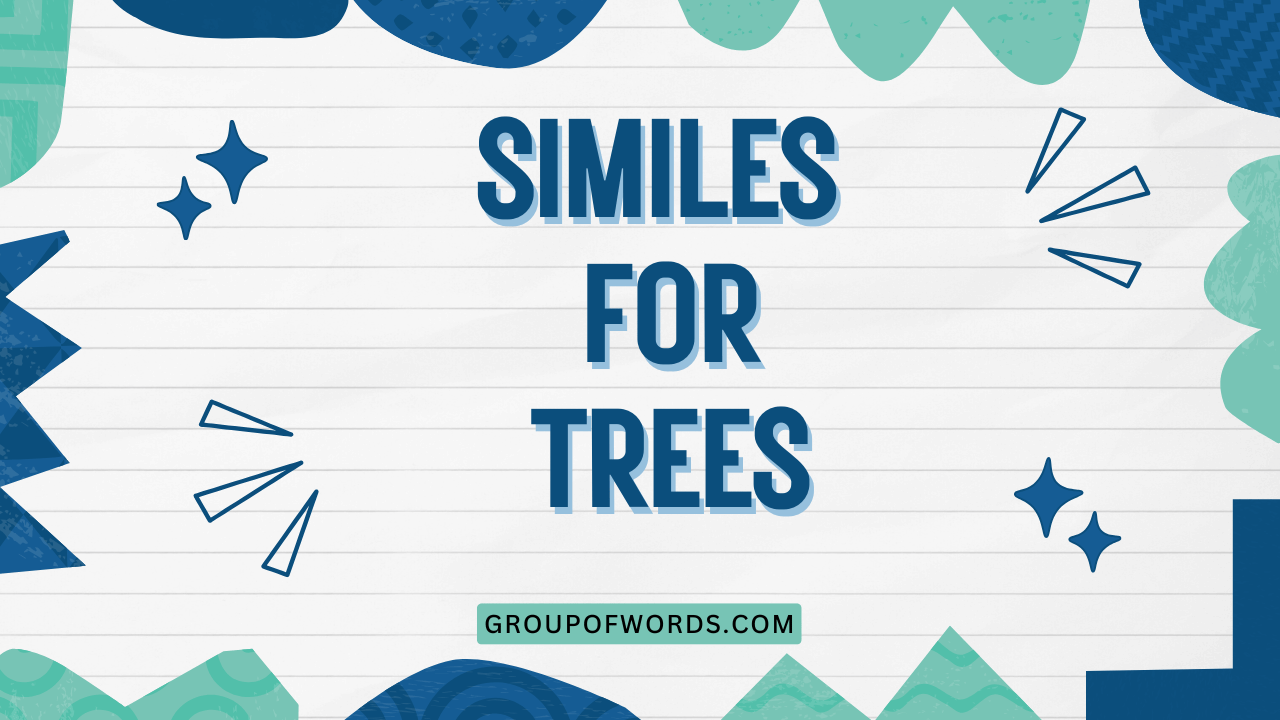Trees in Comparison: Mastering Similes for Vivid Descriptions
Similes are powerful tools in the English language, allowing us to create vivid and engaging descriptions by comparing one thing to another. When it comes to describing trees, similes can bring these natural wonders to life in our writing and speech.
Understanding how to effectively use similes for trees can significantly enhance your descriptive abilities, making your language more evocative and impactful. This article will delve into the art of crafting similes for trees, exploring various types, usage rules, common mistakes, and providing ample examples and practice exercises to solidify your understanding.
Whether you’re a student, writer, or simply someone who appreciates the beauty of language, this comprehensive guide will equip you with the knowledge and skills to master the use of similes when describing trees.
This guide is designed to assist English language learners, creative writers, and anyone looking to enhance their descriptive writing skills. By understanding the structure and application of similes specifically related to trees, you can enrich your vocabulary and create more impactful imagery in your communication.
Table of Contents
- Introduction
- Definition of Simile
- Structural Breakdown of Similes
- Types of Similes for Trees
- Examples of Similes for Trees
- Usage Rules for Similes
- Common Mistakes with Similes
- Practice Exercises
- Advanced Topics in Similes
- Frequently Asked Questions
- Conclusion
Definition of Simile
A simile is a figure of speech that compares two unlike things using the words “like” or “as.” It is a powerful tool for creating vivid imagery and enhancing descriptive writing. The primary function of a simile is to illuminate a particular quality of one thing by drawing a parallel to another, thereby making the description more engaging and understandable.
Similes are frequently used in literature, poetry, and everyday conversation to add depth and color to language.
In essence, a simile serves as a bridge, connecting two seemingly different concepts to highlight a shared characteristic. This connection allows the reader or listener to visualize and understand the subject in a new and more impactful way.
For example, saying “the tree stood tall like a guardian” not only describes the tree’s height but also evokes a sense of protection and strength.
Structural Breakdown of Similes
The basic structure of a simile consists of three key components: the subject being described, the word “like” or “as,” and the object to which the subject is being compared. Understanding this structure is crucial for creating effective and grammatically correct similes.
The formula is straightforward: Subject + “like” or “as” + Object of Comparison. Let’s break this down further:
- Subject: This is the thing you are describing. In our case, it will often be a tree or a part of a tree (e.g., “The oak tree,” “The branches”).
- “Like” or “As”: These are the words that signal a comparison is being made. They are interchangeable in many cases, though “as” can sometimes imply a stronger degree of similarity.
- Object of Comparison: This is the thing to which you are comparing the subject. It should share a relevant characteristic with the subject. (e.g., “a fortress,” “a dancer”).
For instance, in the simile “The willow’s branches swayed like a dancer’s arms,” the willow’s branches are the subject, “like” is the comparison word, and “a dancer’s arms” is the object of comparison. The shared characteristic being highlighted is the graceful, flowing movement.
Types of Similes for Trees
Similes for trees can be categorized based on the aspect of the tree being described. Here are some common types:
Similes Describing Appearance
These similes focus on the visual characteristics of the tree, such as its height, shape, color, or overall appearance. They help to create a clear and vivid mental image.
Similes Describing Movement
These similes capture how the tree moves, whether it’s swaying in the wind, bending under a load of snow, or rustling its leaves. They bring a sense of dynamism to the description.
Similes Describing Sound
These similes evoke the sounds associated with trees, such as the rustling of leaves, the creaking of branches, or the whistling of wind through the canopy. These similes engage the auditory sense of the reader.
Similes Describing Strength
These similes emphasize the tree’s resilience, durability, and power. They often compare the tree to strong or enduring objects.
Similes Describing Age
These similes highlight the age and wisdom of older trees, often comparing them to ancient figures or historical landmarks.
Similes Describing Texture
These similes focus on the feel of the tree’s bark, leaves, or branches, providing a tactile element to the description.
Examples of Similes for Trees
To illustrate the different types of similes, here are several examples categorized by the aspect of the tree they describe.
Appearance Examples
The following table provides examples of similes that describe the appearance of trees. They focus on characteristics such as height, shape, color, and overall visual impression.
| Simile | Explanation |
|---|---|
| The redwood stood as tall as a skyscraper. | Compares the redwood’s height to a very tall building. |
| The oak’s branches spread like the arms of an ancient giant. | Describes the wide, expansive reach of the oak’s branches. |
| The birch tree was as white as fresh snow. | Highlights the bright white color of the birch’s bark. |
| The pine tree was shaped like a perfect pyramid. | Describes the tree’s symmetrical, conical form. |
| The willow’s leaves shimmered like emerald jewels. | Compares the leaves’ color and shine to precious gems. |
| The maple tree blazed as red as a bonfire. | Emphasizes the vibrant red color of the maple’s leaves in autumn. |
| The cypress stood as straight as an arrow. | Describes the upright, unwavering posture of the cypress. |
| The tree’s silhouette was like a dark painting against the sunset. | Focuses on the dramatic outline of the tree against the colorful sky. |
| The leaves were as green as a summer meadow. | Highlights the lush, vibrant green of the leaves. |
| The tree looked like a tangled sculpture of wood and leaves. | Describes the intricate, artistic appearance of the tree. |
| The bare branches resembled skeletal fingers reaching to the sky. | Creates a stark, evocative image of the winter tree. |
| The tree’s canopy was like a vast, green umbrella. | Describes the wide, protective cover of the tree’s leaves. |
| The tree stood as proud as a king on his throne. | Conveys a sense of dignity and majesty. |
| The tree was as round as a giant lollipop. | Uses a playful comparison to describe a round tree shape. |
| The tree’s roots looked like a web of ancient veins. | Describes the intricate, aged appearance of the roots. |
| The tree appeared like a green cloud from a distance. | Describes the tree’s overall shape and color from afar. |
| The tree stood as a lonely sentinel on the hilltop. | Emphasizes the tree’s solitary and watchful presence. |
| The tree’s bark was as rough as sandpaper. | Describes the coarse texture of the bark. |
| The tree’s trunk was as thick as a car. | Highlights the massive girth of the tree’s trunk. |
| The tree looked like a giant broccoli floret. | Uses a humorous comparison to describe the tree’s shape. |
| The tree’s autumn leaves were as bright as stained glass. | Compares the leaves to the vibrant colors of stained glass windows. |
| The tree’s form was graceful like a ballerina. | Describes the graceful and elegant form of the tree. |
| The tree’s appearance was as striking as a lightning bolt. | Emphasizes the tree’s dramatic and attention-grabbing appearance. |
Movement Examples
The following table provides examples of similes that describe the movement of trees, focusing on how they sway, bend, and rustle in the wind.
| Simile | Explanation |
|---|---|
| The branches swayed like dancers in the breeze. | Compares the branches’ movement to the graceful movements of dancers. |
| The leaves rustled like whispers in the wind. | Describes the soft, murmuring sound and movement of the leaves. |
| The tree bent like a bow in the storm. | Emphasizes the tree’s flexibility and resilience in strong winds. |
| The willow’s branches moved like a flowing river. | Describes the smooth, continuous motion of the branches. |
| The leaves fluttered like butterflies in the air. | Compares the leaves’ light, erratic movement to butterflies. |
| The tree swayed back and forth like a metronome. | Describes the rhythmic, regular swaying of the tree. |
| The branches reached out like grasping hands in the wind. | Conveys a sense of the branches actively moving and reaching. |
| The tree shuddered like a dog shaking off water. | Describes a sudden, trembling movement of the tree. |
| The leaves spun like tiny propellers in the wind. | Emphasizes the rapid, whirling motion of the leaves. |
| The tree bobbed and weaved like a ship in a storm. | Compares the tree’s movement to a ship struggling against rough seas. |
| The branches undulated like waves on the ocean. | Describes the smooth, rolling movement of the branches. |
| The tree trembled like a leaf in a hurricane. | Emphasizes the intensity and vulnerability of the tree’s movement. |
| The branches danced like ribbons in the wind. | Conveys a sense of lightness and joy in the movement. |
| The leaves swirled like confetti in the air. | Describes the scattered, celebratory movement of the leaves. |
| The tree dipped and swayed like a curtsying dancer. | Adds a sense of elegance and grace to the movement. |
| The tree moved with the wind like a conductor leading an orchestra. | Emphasizes the tree’s role in orchestrating the sounds of nature. |
| The leaves turned like pages in a book. | Describes the gentle turning of the leaves in a breeze. |
| The tree responded to the wind like a seasoned sailor to the sea. | Highlights the tree’s experience and adaptation to the elements. |
| The branches shook like a nervous person’s hands. | Compares the branches’ movement to a sign of nervousness or anxiety. |
| The tree swayed like a hypnotized subject. | Describes a slow, trance-like movement of the tree. |
| The tree’s branches moved like a cat stretching. | Describes the slow and deliberate movement of tree limbs. |
| The wind flowed through the tree’s leaves like water through a sieve. | Illustrates how the wind passes through the tree’s leaves. |
| The tree’s movement was as fluid as a waterfall. | Emphasizes the smooth and continuous movement of the tree. |
Sound Examples
The following table provides examples of similes that describe the sounds associated with trees, such as the rustling of leaves and the creaking of branches.
| Simile | Explanation |
|---|---|
| The leaves rustled like soft whispers. | Compares the sound of the leaves to hushed, gentle voices. |
| The branches creaked like an old man’s bones. | Describes the sound of the branches as aged and brittle. |
| The wind through the leaves sounded like a gentle stream. | Compares the sound to the soothing sound of flowing water. |
| The rustling of the leaves was like the sound of rain falling softly. | Describes the gentle, consistent sound of the leaves. |
| The creaking of the tree sounded like a door groaning open. | Compares the sound to the strained sound of an opening door. |
| The wind howled through the branches like a mournful wolf. | Emphasizes the intense, sorrowful sound of the wind. |
| The leaves sighed like a weary traveler. | Describes a soft, breathy sound of the leaves. |
| The branches rubbed together like sandpaper. | Compares the sound to the rough, grating sound of sandpaper. |
| The wind whispered secrets through the trees like old friends. | Adds a sense of intimacy and mystery to the sound. |
| The leaves chattered like excited children. | Describes a lively, animated sound of the leaves. |
| The tree’s creaks echoed like a haunted house. | Conveys a sense of eeriness and mystery in the sound. |
| The leaves murmured like a crowd in the distance. | Describes a low, indistinct sound of the leaves. |
| The wind shrieked through the branches like a banshee. | Emphasizes the high-pitched, piercing sound of the wind. |
| The leaves hissed like a snake in the grass. | Compares the sound to the sharp, sibilant sound of a snake. |
| The tree groaned like a ship in distress. | Describes a deep, strained sound of the tree. |
| The wind sounded like a flute playing through the trees. | Highlights the melodious and harmonious quality of the wind’s sound. |
| The leaves sang like a choir of angels. | Describes the beautiful and harmonious sound of the leaves. |
| The tree’s sounds were as soothing as a lullaby. | Emphasizes the calming and comforting nature of the sounds. |
| The wind whistled through the tree like a kettle boiling. | Compares the sound to the high-pitched whistle of a boiling kettle. |
| The leaves rustled like paper, telling stories of the forest. | Describes the leaves as if they are telling stories. |
| The tree’s sounds were like the earth breathing. | Highlights the sounds as a natural and vital part of the earth. |
| The wind whispered through the trees like a secret. | Implies the winds holds secret to the forest. |
| The leaves sounded like children giggling. | Compares the leaves to the joyous sound of kids. |
Strength Examples
The following table provides examples of similes that describe the strength and resilience of trees.
| Simile | Explanation |
|---|---|
| The oak stood as strong as a fortress. | Compares the oak’s strength to a fortified structure. |
| The tree was as resilient as a mountain. | Highlights the tree’s ability to withstand hardship. |
| The roots held the tree like anchors in the earth. | Describes the strong, unwavering grip of the roots. |
| The tree stood firm like a warrior in battle. | Emphasizes the tree’s unwavering strength and stability. |
| The tree was as unyielding as a stone wall. | Highlights the tree’s resistance to bending or breaking. |
| The bark was as tough as leather. | Describes the durable, protective quality of the bark. |
| The tree weathered the storm like a seasoned sailor. | Compares the tree’s endurance to an experienced sailor. |
| The tree stood tall like a beacon of strength. | Conveys a sense of the tree’s unwavering presence. |
| The tree’s grip on the earth was as strong as a vise. | Emphasizes the powerful hold of the roots. |
| The tree endured like a timeless monument. | Highlights the tree’s enduring quality over time. |
| The tree stood as a bulwark against the wind. | Describes the tree’s role in protecting against the elements. |
| The tree’s presence was as commanding as a general. | Conveys a sense of authority and power. |
| The tree was as steadfast as a lighthouse. | Highlights the tree’s reliability and stability. |
| The tree’s roots were like iron claws gripping the earth. | Emphasizes the strong, unyielding grip of the roots. |
| The tree stood unbent like a stubborn mule. | Highlights the tree’s resistance to being moved or influenced. |
| The tree’s strength was as immutable as the laws of nature. | Emphasizes the absolute and unchanging nature of its strength. |
| The tree’s resilience shined like a diamond under pressure. | Compares the tree’s resilience to the strength of a diamond. |
| The tree was as immovable as a mountain. | Highlights the tree’s impressive power. |
| The tree’s trunk stood strong like a pillar of the earth. | Emphasizes the trunk’s role as a foundational element. |
| The tree’s survival was as inevitable as the sunrise. | Describes the tree’s survival as certain and unstoppable. |
| The tree was as dependable as the changing seasons. | Highlights the tree’s reliability. |
| The tree’s spirit was as unbreakable as a diamond. | Emphasizes the strength of the tree. |
| The tree’s strength was as deep as the earth. | Compares the tree to the vastness of the earth. |
Age Examples
The following table provides examples of similes that describe the age and wisdom of trees.
| Simile | Explanation |
|---|---|
| The ancient oak stood as old as time itself. | Compares the oak’s age to the vastness of time. |
| The tree was as wise as an ancient sage. | Highlights the tree’s perceived wisdom and knowledge. |
| The tree’s rings told stories like pages in a history book. | Describes the rings as a record of the tree’s life and experiences. |
| The tree stood as a living monument to the past. | Emphasizes the tree’s role as a connection to history. |
| The tree was as weathered as an old sailor’s face. | Compares the tree’s appearance to the aged features of a sailor. |
| The tree’s branches were gnarled like an old woman’s hands. | Describes the twisted, aged appearance of the branches. |
| The tree stood as a silent witness to history. | Conveys a sense of the tree’s long-term observation of events. |
| The tree was as ancient as the hills. | Highlights the tree’s great age and enduring presence. |
| The tree’s presence was like a grandfather watching over the land. | Adds a sense of protection and care to the tree’s age. |
| The tree’s roots were like the veins of the earth itself. | Describes the deep, interconnected nature of the roots. |
| The tree’s wisdom was as deep as its roots. | Emphasizes the connection between age and knowledge. |
| The tree stood as a guardian of the forest’s secrets. | Conveys a sense of mystery and hidden knowledge. |
| The tree’s age was as immeasurable as the stars. | Highlights the vastness and unknowable nature of its age. |
| The tree looked like a wizened old man, full of stories. | Adds a human-like quality to the tree’s age and wisdom. |
| The tree stood like a sentinel from a forgotten era. | Emphasizes the tree’s connection to a distant past. |
| The tree’s endurance was as long as a dynasty. | Compares the tree’s long life to a royal dynasty. |
| The tree’s memories were stored like rings in its trunk. | Highlights the tree’s ability to retain history within its structure. |
| The tree’s ancient presence was as profound as a sacred text. | Compares the tree to a source of wisdom and reverence. |
| The tree stood as a testament to the passage of time. | Emphasizes the tree’s role as a symbol of enduring time. |
| The tree’s age was as vast as the ocean. | Highlights the tree’s long life as a vast part of nature. |
| The tree’s wisdom was as vast as the universe. | Compares the tree’s wisdom with the vastness of space. |
| The tree’s presence was as comforting as a familiar song. | Emphasizes the tree’s presence and age. |
| The tree was like a wise old friend. | Compares the tree to a friend. |
Texture Examples
The following table provides examples of similes that describe the texture of trees and their parts.
| Simile | Explanation |
|---|---|
| The bark was as rough as sandpaper. | Compares the bark’s texture to coarse sandpaper. |
| The leaves felt like velvet to the touch. | Describes the leaves as soft and smooth like velvet. |
| The trunk was as smooth as polished stone. | Highlights the smooth, refined texture of the trunk. |
| The branches were as prickly as a cactus. | Compares the branches to the sharp, thorny texture of a cactus. |
| The moss felt like a soft, green carpet on the bark. | Describes the moss as soft and inviting like a carpet. |
| The bark was as furrowed as a plowed field. | Compares the bark’s texture to the ridges and grooves of a field. |
| The leaves were as crisp as autumn air. | Describes the leaves as dry and brittle. |
| The trunk was as rugged as a mountain face. | Highlights the rough, uneven texture of the trunk. |
| The sap felt as sticky as honey. | Compares the sap’s texture to the thick, adhesive quality of honey. |
| The wood was as hard as iron. | Describes the wood as dense and unyielding. |
| The bark was as scaly as a reptile’s skin. | Compares the bark’s texture to the overlapping scales of a reptile. |
| The leaves felt like parchment in the hand. | Describes the leaves as thin, dry, and slightly rough. |
| The trunk was as smooth as glass. | Highlights the exceptionally smooth texture of the trunk. |
| The branches were as twisted and knotted as old rope. | Describes the complex, tangled texture of the branches. |
| The bark was as flaky as pastry. | Compares the bark’s texture to the layered, peeling quality of pastry. |
| The tree’s texture felt like the earth itself. | Compares the tree’s texture to the natural feel of the earth. |
| The leaves felt like silk under my fingers. | Describes the soft smooth feel. |
| The tree’s rough bark was like a map of the forest’s history. | Describes the bark as a chart of knowledge. |
| The tree’s texture was as comforting as a warm blanket. | Compares the tree’s texture to a warm feeling. |
| The tree’s leaves felt like thousands of tiny hands. | Describes the leaves as tiny hands. |
| The bark’s texture was as complex as a fingerprint. | Compares the bark to a unique fingerprint. |
| The tree’s texture was as natural as the wind. | Emphasizes the texture. |
| The tree’s texture was like an old book. | Compares the tree to a story. |
Usage Rules for Similes
When using similes, it’s essential to follow certain rules to ensure clarity and effectiveness:
- Clarity: The comparison should be clear and easily understood. The shared characteristic between the subject and the object of comparison should be evident.
- Relevance: The object of comparison should be relevant to the subject. The comparison should make sense in the context of the description.
- Originality: While common similes can be effective, strive for originality to make your writing more engaging and memorable. Avoid clichés.
- Appropriateness: The simile should be appropriate for the tone and style of your writing. Consider your audience and the overall message you want to convey.
- Grammar: Ensure that your simile is grammatically correct. The use of “like” or “as” should be followed by a noun or pronoun.
For example, instead of saying “The tree was big like a thing,” which is vague and unclear, you could say “The tree was as big as a house,” which provides a clear and relatable comparison.
Common Mistakes with Similes
Several common mistakes can undermine the effectiveness of similes. Being aware of these errors can help you avoid them in your own writing.
| Mistake | Correct Example | Incorrect Example |
|---|---|---|
| Using clichés | The tree stood as proud as a newly crowned king. | The tree was as tall as a house. (Overused) |
| Unclear comparison | The leaves were as green as a summer meadow. | The leaves were as green as a color. (Vague) |
| Irrelevant comparison | The branches swayed like dancers in the breeze. | The branches swayed like a car driving fast. (Makes no sense) |
| Grammatical errors | The tree was as strong as an ox. | The tree was strong like be ox. (Incorrect grammar) |
| Overuse of similes | The tree stood tall, its leaves whispering secrets. | The tree was as tall as a skyscraper, and its leaves were like whispers, and its bark was as rough as sandpaper. (Too many similes) |
Clichés are overused expressions that have lost their impact. Avoid them by crafting fresh, original comparisons. Ensure your similes are clear by making the shared characteristic obvious. The comparison should also be relevant, making sense in the context of your description. Don’t forget to check for grammatical errors, and be mindful of overusing similes, as too many can make your writing feel cluttered and forced.
Practice Exercises
Test your understanding of similes with these practice exercises. Fill in the blanks with appropriate comparisons to complete the similes.
| Question | Answer |
|---|---|
| 1. The tree’s bark was as rough as __________. | sandpaper |
| 2. The leaves rustled like __________. | whispers |
| 3. The branches swayed like __________ in the wind. | dancers |
| 4. The tree stood as tall as __________. | a skyscraper |
| 5. The roots were as strong as __________. | anchors |
| 6. The tree was as old as __________. | time itself |
| 7. The leaves were as green as __________. | a summer meadow |
| 8. The tree’s canopy was like __________. | a vast, green umbrella |
| 9. The tree bent like __________ in the storm. | a bow |
| 10. The tree was as wise as __________. | an ancient sage |
Advanced Practice: Rewrite the following sentences using similes to make them more descriptive.
| Original Sentence | Simile-Enhanced Sentence |
|---|---|
| 1. The tree was very tall. | The tree stood as tall as a skyscraper, piercing the sky. |
| 2. The wind made a soft sound in the leaves. | The wind whispered secrets through the leaves, like old friends sharing stories. |
| 3. The tree was strong and resilient. | The tree stood as strong
as a fortress, resilient against the harshest storms. |
Advanced Topics in Similes
Once you’ve mastered the basics of similes, you can explore more advanced techniques to enhance your writing further. These include using extended similes, combining similes with other figures of speech, and tailoring similes to specific audiences.
- Extended Similes: These are longer, more detailed comparisons that extend over several sentences or even paragraphs. They allow for a deeper exploration of the shared characteristics between the subject and the object of comparison.
- Combining with Other Figures of Speech: Similes can be combined with metaphors, personification, and other figures of speech to create richer, more complex descriptions. For example, you could use a simile to introduce a metaphor: “The tree stood as tall as a skyscraper, a verdant giant watching over the city.”
- Audience-Specific Similes: Consider your audience when crafting similes. A simile that resonates with one audience may not be effective for another. Tailor your comparisons to the knowledge, experiences, and interests of your readers.
By experimenting with these advanced techniques, you can elevate your writing and create truly memorable descriptions.
Frequently Asked Questions
What is the difference between a simile and a metaphor?
A simile compares two things using “like” or “as,” while a metaphor directly equates two things without using these words. For example, “The tree is like a fortress” (simile) versus “The tree is a fortress” (metaphor).
Can a simile be too long?
Yes, a simile can be too long if it becomes convoluted or distracts from the main point. Aim for clarity and conciseness, even in extended similes.
How can I make my similes more original?
Avoid clichés and think outside the box. Consider unique characteristics of the subject and look for unexpected comparisons that highlight those qualities.
Is it okay to use multiple similes in a single paragraph?
Yes, but use them sparingly. Too many similes can make your writing feel cluttered.
Focus on quality over quantity.
Can similes be used in formal writing?
Yes, similes can be used in formal writing, but they should be used judiciously and appropriately. Ensure they enhance the clarity and impact of your message without detracting from the formality of the piece.
How do I choose the right object of comparison for a simile?
Choose an object that shares a relevant characteristic with the subject you are describing. The comparison should make sense and create a vivid image in the reader’s mind.
Conclusion
Mastering the art of crafting similes for trees can significantly enhance your descriptive writing skills. By understanding the structure, types, and usage rules of similes, you can create vivid and engaging descriptions that bring trees to life in the reader’s mind.
Remember to avoid common mistakes, strive for originality, and tailor your similes to your audience. With practice and attention to detail, you can harness the power of similes to elevate your writing and express your appreciation for the natural world.






